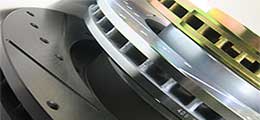If you’re new to buying brakes or aren’t too familiar with auto industry lingo, this post is for you!
The most important part of buying aftermarket brakes is making sure they’re compatible with your vehicle. Besides, what good are the parts if they don’t fit?
Here’s a list of some basic terms will help determine proper fitment:
- Production Date– Usually just the year your vehicle was manufactured. The production month isn’t always needed, but for vehicles that have a split in production within a year (e.g. 2002 Subaru Impreza WRX) the rotors can change depending on the month the vehicle was produced.
TIP: Some ways you can find the production date of a vehicle:
- On a sticker or tag within the driver side door jam.
- Through the Vehicle Identification Number (VIN). Here is a cool article that describes how.
- Make and Model – Make refers to the company that made the car (e.g. Mercedes, BMW, Ford, Chevrolet, Toyota, Honda, etc.). The model are the cars that these automakers sell (E320, X5, Mustang, Camaro, Prius, Civic etc.)
- Sub-model or Trim Level – Sub-models or trim levels are different versions of vehicle models that include specific features and varying levels of equipment. For example, the 2010 Honda Civic has the following trim levels or sub-models: DX, LX, EX models, etc. Here is a quick break-down of what specific features are included for some sub-models:
- DX – is the entry level Honda Civic that has all of the standard features with the lowest price.
- LX – occupies the mid-level spot in the Civic lineup and includes features not found on the entry-level DX trims. Some examples would be power door locks, cruise control, and a center console with a sliding armrest, just to name a few.
- EX- adds a number of upscale standard features not found on other Civic trims, such as leather-trimmed upholstery and heated front seats and heated exterior side mirrors.
- Options and Packages – Options are extra features that are not standard equipped with the vehicle. Some manufacturers offer a Performance Package which may involve equipping the vehicle with aerodynamic trims and/or larger brakes.
- Drive-train – This is the method of propulsion of your vehicle. Is your vehicle two-wheel drive (2WD) or four-wheel drive (4WD)?
- Rotor diameter – The rotor diameter is the outer-diameter of the brake disc. Some vehicles can have up to four different size options that were offered (e.g. Porsche Cayenne has 330mm, 350mm, 380mm, 410mm).
- Wheel Hub Assembly – the area at the center of the wheel that houses the bearings and hold the wheel parts together. Some applications have a rotor and hub assembly, which is one piece or can be separate pieces. It’s important to distinguish which you have so that you have all the components to complete the brake job.
- Suspension – the system of tires, tire air, springs, shock absorbers and linkages that connects a vehicle to its wheels and allows relative motion between the two. Some vehicles are offered with Heavy Duty or Standard Suspension and this can have a direct influence on the brakes that are used.
- OEM – Original Equipment Manufacturer – Company that produces the original parts of the car. OEM part numbers can be used to help identify the exact part that was used on the vehicle.
- Brake Conversion – Replacing the original brakes with brakes from a donor vehicle or with a Big Brake Kit (BBK). If your vehicle had a brake conversion done, it’s important to know the donor vehicle the parts came from, so that we can provide the corresponding brake parts.
- BBK – big brake kit or larger brake system that includes calipers, rotors, brake pads, brake lines. This is ideal for more demanding applications such as racing.
- Body style – coupe (2-door), Sedan (4-door), convertible, etc.
In many situations, knowing just the year, make, and model of the vehicle can help determine the right parts. WIth the ever-growing set of options of vehicles these days, don't be surprised if you're asked to specify some of the information above.
Were any of these terms new to you? Did we miss anything? Share your thoughts with us in the comments below!









